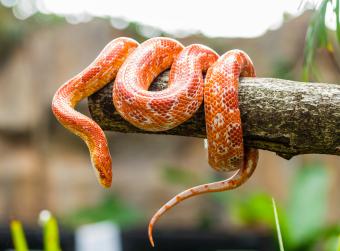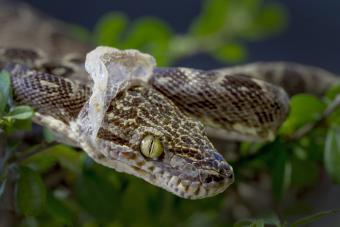
Corn snakes are popular pet snakes, and they are popular with beginner reptile keepers because they're relatively easy to care for. These beautiful North American reptiles are relatively small and inexpensive, so they make a good choice if you're just starting to get into snake keeping.
Background and Native Habitat
Corn snakes (Pantherophis guttatus) are found in the eastern United States and range from New Jersey to Florida, and as far west as Kentucky. They are closely related to king snakes. As their name denotes, corn snakes can be found in cornfields, but also occur in a variety of areas, including gardens, barns, abandoned buildings, meadows, and wooded areas.
General Characteristics

For a long time, corn snakes were thought to be a species of rat snake. However, genetic studies confirmed they are more closely related to king snakes. Corn snakes are the most popular pet snake in the world. They are so popular because they are easy to take care of and have a very docile temperament. Corn snakes go by many names, including red rat snake, chicken snake, and red chicken snake.
Appearance and Size
The corn snake is a medium to large species of snake, with adults commonly growing to 2 to 4 feet in length. These snakes come in a wide variety of colors, patterns, and morphs, including albinos. Some of the most common colors include red, yellow, orange, peach, pink, and white. Some corn snakes have spots or stripes on their backs; others have no markings at all.
Lifespan
Corn snakes do not typically live as long in the wild as they do in captivity. In the wild, they will usually only live 2 to 3 years due to predators and lack of food sources. When cared for properly in captivity, they can live for 20 years or more.
Although it's possible for a captive corn snake to live for more than 20 years, most don't make it to this age. However, the record for the longest-lived corn snake in captivity is more than 32 years.
Temperament
Corn snakes are generally considered to be gentle and docile, but they can also be quite feisty. They are very curious animals, and they love to explore their surroundings. When they feel threatened, they will hiss loudly and coil tightly around themselves. If the threat persists, they will strike at their attacker.
Corn snakes are primarily terrestrial snakes, meaning that they spend most of their lives on land rather than in water. However, they do enjoy spending time in water during the summer months to cool off and catch prey. The corn snake is an excellent choice for a first pet snake because it is relatively easy to care for and handle correctly.
Color Misconception
There are also some common misconceptions surrounding corn snake colors that affect their temperament. For example, many people believe that red-colored corn snakes are more aggressive than other colors because red is an uncommon color among these reptiles.
This is simply not true; there is no scientific evidence to support this claim. Red-colored corn snakes may look more intimidating because of their bright coloration, but this does not mean that they have an aggressive disposition or personality.

Care Requirements
The corn snake's care requirements aren't excessive, but you still need to make sure their needs are met. The hardest part of owning a corn snake involves setting up their terrarium, which also isn't particularly difficult.
Terrarium Setup Guidelines
The size of their enclosure is important. Corn snakes grow to be about 4 feet long, so you need a large cage to keep your snake happy and healthy. Baby snakes can live in a 10-gallon tank for a short period of time, but adults should be provided a 40-gallon tank, or larger if possible.
Provide your corn snake with several hides - at least two, but more are better - placed in different spots within their setup. These allow your snake to get out of the light and feel secure. Your corn snake needs a safe place to sleep, and you can add damp sphagnum moss to increase humidity in the hide closest to the warmer side of the terrarium.
Corn snakes are an independent species and prefer to be housed alone.
Temperature and Humidity
The temperature in their tank should vary - this is known as a temperature gradient. One end, where the light is located, keep temperatures between 80 and 85 degrees Fahrenheit. The cooler end should be between 70 and 75 degrees Fahrenheit. This can be accomplished by placing a heating pad or heating coil beneath the warmer side of the tank.
Place temperature and humidity gauges on each side of the terrarium to monitor conditions in your snake's enclosure. Keep your corn snake's terrarium humidity levels between 40 and 60%. Raise this level to 70% during shedding periods. Then, bring the humidity back to normal once your snake has finished shedding.
If you notice your snake isn't shedding well, even with the higher humidity level, daily misting with warm water is recommended.
Lighting Requirements
Your corn snake's light should be on for a minimum of 8 hours each day; 12 hours maximum. This helps them adjust to their seasonal life cycle patterns. Avoid placing your snake's terrarium in a window that allows natural sunlight into the enclosure. This can cause temperatures to rise to dangerous levels very quickly.
Traditional thinking held that corn snakes do not need special lighting that provides ultraviolet (UV) radiation to help them produce vitamin D3, but recent studies have confirmed that corn snakes do produce D3 from UV light exposure. While corn snakes get most of the vitamin D3 and calcium they need from their diet, adding a special UV bulb to your terrarium is likely to improve their overall health.

Substrate
You can choose from several substrate types, including reptile carpet, paper bedding, or aspen shavings. There are also several commercial options available at most pet stores, such as Zoo Med Eco Earth, which is made of loose coconut fibers. Never use pine or cedar, as these can irritate your snake's skin, cause respiratory distress and other health problems.
Change your snake's bedding every 7 to 14 days. Young corn snakes and juveniles do well on paper towels or newspaper used as bedding. You can also use ground coverings, such as hay or straw, to give your corn snake something to slither through and burrow into.
Diet and Water
A corn snake diet should include the following:
- Rodents: The main staple of any corn snake's diet should be pre-killed mice or rats that are available at pet stores. These rodents are both nutritious and easy for the snake to digest. Snakes may also eat live prey such as mice or rats, but this is not necessary. If your snake does not take pre-killed rodents, you will have to kill your own, so keep this in mind before purchasing one as a pet. Live rodents can cause injury, so remove these from your snake's enclosure after an hour or two.
- Rodent supplements: Some people supplement their snakes' diets with vitamin-enriched feeder insects such as crickets or mealworms, which is not recommended. While these insects do provide some nutrients, they lack others that are found in rodents such as calcium and vitamin D3, which is important for proper bone development in the young snakes.
Provide fresh, clean water to your corn snake at all times. A flat, shallow, heavy bowl designed for use with reptiles is ideal. Deeper bowls are not recommended for corn snakes.
Young corn snakes should be fed baby mice, known as pinkies, rather than adult mice.

Handling Your Corn Snake
When they first hatch, corn snakes are relatively timid. They will be defensive, hiding away from you and displaying nervous behavior. Baby corn snakes may even become aggressive if you move too quickly to handle them. It takes time - and proper socialization - for them to accept handling.
Wait a few weeks for your corn snake to settle into their new home. Give them a few meals, and let them begin to calm down before you try to handle them. To pick up your snake, move your hand in from the side in a smooth, consistent motion. Lift up your corn snake gently, supporting its head and body with both hands. Don't hover your hand over your snake; they read this as predatory behavior.
Never handle or pick up your corn snake after a meal. Wait at least 48 hours before you disturb your snake, or you run the risk of causing your snake to get upset and regurgitate its food.
Health Concerns
Corn snakes are prone to the following health issues:
- Stomatitis: This condition, also known as mouth rot, occurs when bacteria enters and open wound infecting the gums and mouth. Signs include swelling in the mouth, lack of appetite, or frothy discharge.
- Mites: Corn snakes are prone to mites. Mites live on the snake's body and feed on their blood. You may notice them around the eyes and mouth or under your snake's scales. If your snake has mites, they are in their cage, so their cage must be disinfected and the snake should be bathed in warm water.
- Constipation: This condition occurs when they don't eat enough food or they don't digest their food properly. Constipation can be fatal if left untreated, as it can lead to impaction or intestinal blockage if the problem is not resolved quickly enough.
When corn snakes become juveniles, they begin to shed their skin every six weeks or so. As adults, you can expect corn snakes to shed around every three months.
Finding a Corn Snake
People who have owned corn snakes before usually recommend getting your snake from a breeder. A breeder is someone who specializes in raising these snakes, and they'll know more than anyone else about the characteristics of their animals.
A reputable breeder will also have a good reputation for selling healthy animals, and cares about finding owners who will give their snakes a good home after they're sold. This means that if you buy from a breeder, your corn snake will likely be healthy. You can expect to pay between $100 to $200 for a corn snake from a breeder.

Are Corn Snakes for You?
If you're looking for a snake that's easy to care for and that can be handled regularly, then a corn snake is the right choice. These snakes are generally quite docile and not aggressive, making them ideal for first-time snake owners. They're also relatively inexpensive in comparison to other snake types, which makes them easier to keep as pets.







